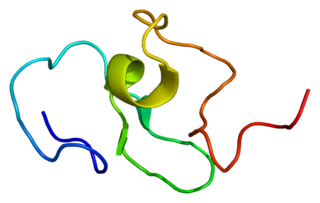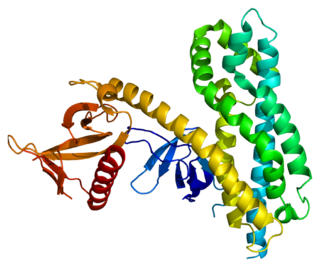
Chromobox protein homolog 1 is a protein that in humans is encoded by the CBX1 gene.

Tyrosine-protein kinase, or Bromodomain adjacent to zinc finger domain, 1B (BAZ1B) is an enzyme that in humans is encoded by the BAZ1B gene.

AT-rich interactive domain-containing protein 2 (ARID2) is a protein that in humans is encoded by the ARID2 gene.

Sorting nexin-5 is a protein that in humans is encoded by the SNX5 gene.

Protein Jumonji is a protein that in humans is encoded by the JARID2 gene. JARID2 is a member of the alpha-ketoglutarate-dependent hydroxylase superfamily.

SLC35F6 is a protein that in humans is encoded by the SLC35F6 gene. The orthologue in mice is 4930471M23Rik.

1-acyl-sn-glycerol-3-phosphate acyltransferase gamma is an enzyme that in humans is encoded by the AGPAT3 gene. The protein encoded by this gene is an acyltransferase that converts lysophosphatidic acid into phosphatidic acid, which is the second step in the de novo phospholipid biosynthetic pathway. The encoded protein may be an integral membrane protein. Two transcript variants encoding the same protein have been found for this gene.

WD repeat-containing protein 3 is a protein that in humans is encoded by the WDR3 gene.

SET and MYND domain-containing protein 4 is a protein that in humans is encoded by the SMYD4 gene.

Ninein-like protein is a protein that in humans is encoded by the NINL gene. It is part of the centrosome.

Rho guanine nucleotide exchange factor 4 is a protein that in humans is encoded by the ARHGEF4 gene.

Twinfilin-1 is a protein that in humans is encoded by the TWF1 gene. This gene encodes twinfilin, an actin monomer-binding protein conserved from yeast to mammals. Studies of the mouse counterpart suggest that this protein may be an actin monomer-binding protein, and its localization to cortical G-actin-rich structures may be regulated by the small GTPase RAC1.

Bromodomain testis-specific protein is a protein that in humans is encoded by the BRDT gene. It is a member of the Bromodomain and Extra-terminal motif (BET) protein family.

Ubiquinone biosynthesis protein COQ9, mitochondrial, also known as coenzyme Q9 homolog (COQ9), is a protein that in humans is encoded by the COQ9 gene.

Phosphoribosyl pyrophosphate synthetase-associated protein 2 is a protein that in humans is encoded by the PRPSAP2 gene.

HMG box transcription factor BBX also known as bobby sox homolog or HMG box-containing protein 2 is a protein that in humans is encoded by the BBX gene.

caprin family member 2, also known as CAPRIN2, is a human gene.

The family with sequence similarity 73, member B, also known as FAM73B, is a human gene.

Chromobox homolog 7 is a protein that in humans is encoded by the CBX7 gene. The loss of CBX7 gene expression has been shown to correlate with a malignant form of thyroid cancer.

Additional sex combs like 2, transcriptional regulator is a protein that in humans is encoded by the ASXL2 gene.





















